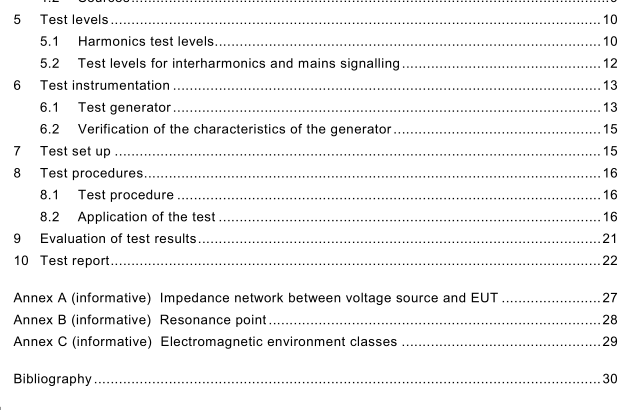IEC 61000-4-13:2009 pdf download – Electromagnetic compatibility (EMC) – Part 4-13: Testing and measurement techniques – Harmonics and interharmonics including mains signalling at a.c. power port, low frequency immunity tests
4 General
4.1 Description of the phenomenon
4.1.1 Harmonics Harmonics are sinusoidal voltages and currents with frequencies that are integer multiples of the frequency at which the supply system operates. Harmonic disturbances are generally caused by equipment with non-linear voltage – current characteristics or by periodic and line-synchronised switching of loads. Such equipment may be regarded as sources of harmonic currents. The harmonic currents from the different sources produce harmonic voltage drops across the impedance of the network. As a result of cable capacitance, line inductance and the connection of power factor correction capacitors, parallel or series resonance may occur in the network and cause a harmonic voltage amplification even at a remote point from the distorting load. The waveforms proposed are the result of the summation of different harmonic orders of one or several harmonic sources.
4.1.2 Interharmonics Between the harmonics of the power frequency voltage and current, further frequencies can be observed which are not an integer multiple of the fundamental. They can appear as discrete frequencies or as a wide-band spectrum. Summation of different interharmonic sources is not likely and is not taken into account in this standard.
4.1.3 Mains signalling (ripple control) Signal frequencies ranging from 1 1 0 Hz to 3 kHz used in networks or parts of them in order to transfer information from a sending point to one or more receiving points. For the scope of this standard, the frequency range is limited to 2 kHz/50 Hz (2,4 kHz/60 Hz).
4.2 Sources
4.2.1 Harmonics Harmonic currents are generated to a small extent by generation, transmission and distribution equipment and to a greater extent by industrial and residential loads. Sometimes, there are only a few sources generating significant harmonic currents in a network; the individual harmonic level of the majority of the other devices is low, nevertheless these may make a relatively high contribution to the harmonic voltage distortion, at least for low order harmonics due to their summation. Significant harmonic currents in a network can be generated by non-linear loads, for example:
– controlled and uncontrolled rectifiers, especially with capacitive smoothing (for example used in television, indirect and direct static frequency converters, and self-ballasted lamps), because these harmonics are in approximately the same phase from different sources and there is only poor compensation in the network;
– phase controlled equipment, some types of computers and UPS equipment. Sources may produce harmonics at a constant or varying level, depending on the method of operation.
4.2.2 Interharmonics Sources of interharmonics can be found in low-voltage networks as well as in medium-voltage and high voltage networks. The interharmonics produced in the medium-voltage/high voltage networks flow in the low-voltage networks they supply and vice versa. The main sources are indirect and direct static frequency converters, welding machines and arc furnaces.
4.2.3 Mains signalling (ripple control) Sources of mains signalling frequencies covered by this standard are transmitters operating mostly in the 1 1 0 Hz to 2 kHz (2,4 kHz) frequency range in order for the public supplier to control equipment in the supply network (public lighting, tariffs for meters, etc.). The transmitter energy is coupled into the system on HV, MV, or LV level. The transmitters operate with interrupted signals, and normally for a short time only. The frequencies used lie normally in between the harmonics.
5 Test levels
The test level is the harmonic voltage specified as a percentage of the fundamental voltage. The voltages given in this standard have the nominal power supply network voltage (U 1 fundamental) as a basis. It is essential that the r.m.s. voltage of the resultant waveforms remain at the nominal value during the application of these tests by adjusting the voltage values of fundamental and harmonics according to the percentages indicated in the corresponding tables (for example 230 V r.m.s., 1 20 V r.m.s.).
5.1 Harmonics test levels The preferential range of test levels for individual harmonics are given in tables 1 to 3. Harmonic voltages at a test level of 3 % and higher, up to the 9th harmonic, shall be applied using a phase shift of both 0° and 1 80° with respect to the positive zero-crossing of the fundamental. Harmonic voltages at a test level of less than 3 % shall be applied using no phase-shift with respect to the positive zero-crossing of the fundamental. For compatibility levels see IEC 61 000-2-2 using factor k. Immunity levels have to be higher (for example times 1 ,5 additionally). The application of the test to a multiphase EUT is given in 8.2.5.
